| |
|
|
|
|
| |
European Tree Websites |
|
|
|
| |
|
|
|
|
| |
Trees as Individuals |
|
Italian Tree Websites |
|
| |
Belgian Tree Websites |
|
Irish Tree Websites |
|
| |
British Tree Websites |
|
Polish Tree Websites |
|
| |
Dutch Tree Websites |
|
Spanish Tree Websites |
|
| |
French Tree Websites |
|
Swedish Tree Websites |
|
| |
German Tree Websites |
|
Swiss Tree Websites |
|
| |
|
|
|
|
| |
|
|
| |
|
|
|
|
| |
Trees as Individuals
Single ancient big trees inspire with awe, and their individuality and historical importance are in some instances recognized by the trees being given proper names. Many European tree websites are dedicated to such monumental and exceptional trees which are fully protected as natural heritage, or nature monuments (Naturdenkmaeler). Yet most of the named trees in Europe are no more than 500 years old and only in exceptional cases do they reach over 800 years. By contrast, in British Columbia (BC), the age of ancient trees may be much greater, up to 2000 years in some cases. These trees are part of primaeval wild forests of the Northwest Coast and their cultural history belongs to the indigenous peoples who stewarded them long before colonization, when the process of deforestation began. |
|
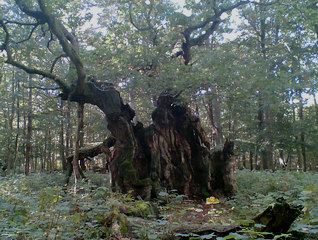
The King Oak (Kongeegen
Jaegerspris Nordskov, Denmark |
|
| |
|
|
 |
|
| |
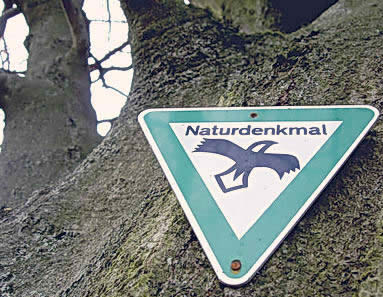
Naturdenkmal. Conservation sign
Photo: Walter J. Pilsak
Die Koenig Ludwig Eiche (the King Ludwig Oak) grows in the Bavarian spa town of Bad Brueckenau (right). The tree is named after King Ludwig I, who placed all old oaks in the area under his special protection and whose favourite tree this was. The King Ludwig Oak has a circumference of over 7 m and is carefully preserved as a "Naturdenkmal" and tourist attraction: note the metal support rods inside the hollowed trunk. Estimates of the age of the venerable oak vary widely, but it is believed to be about 700 years old. Traditionally, under the ample spread of the oak's crown a variety of cultural events were staged; over a hundred people were said to have been able to sit in its shade. |
|
Kongeegen (the King Oak) grows in the royal hunting forest called Jaegerspris Nordskov on the Danish island of Sjaelland (above). It is thought to be about 1500 to 2000 years old and may be the oldest living organism in northern Europe.
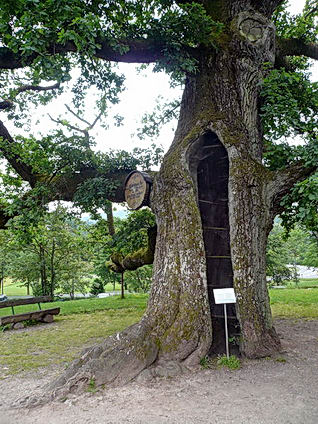
King Ludvig Oak, Bavaria
Photo: Rainer Lippert |
|
| |
|
|
|
|
| |
 |
|
"Great Elm Tree of Shackamaxon (Now Kensington)"
Painted and Engraved by George Lehman. Published by William Smith, Philadelphia, c. 1829 "Under which William Penn concluded his Treaty with the Indians in 1682 it fell during a storm in 1810. This block of marble was placed by the Penn Society AD 1827 to mark the Elm Tree and Treaty Ground of William Penn and the Indian Natives in 1682 and bears the inscriptions, 'Unbroken Faith. By Deeds of Peace.'" |
|
| |
|
|
 |
|
| |
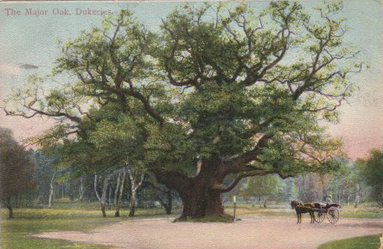
The Major Oak, Dukeries
Sherwood Forest, England |
|
In European countries, individual trees that have survived over the centuries have been revered and respected and given names that reflect their place in history. These trees are historic relics of cultural landscapes but are outclassed by the wild trees that survive in the remnant primaeval temperate rainforests of the Northwest Coast of North America.
The ancient trees that exist in Europe are typically isolated single entities that originated as planted specimens such as the Major Oak of Dukeries, in the Sherwood Forest (left), which is probably from 500 to 700 years old. Legend has it that Robin Hood hid from his enemies inside this ancient tree which had already been described a couple ofcenturies earlier in The Domesday Book of 1086. |
|
| |
|
|
|
|
| |
The Majesty Oak Tree stands on the Fredville Estate Park in Kent and is considered the mightiest and finest of all ancient trees in Britain. She has been the subject of many illustrations such as the engraving (right) from the book "Britannica; or, Portraits of Forest Trees, Distinguished for their Antiquity, Magnitude, or Beauty," published in 1830.
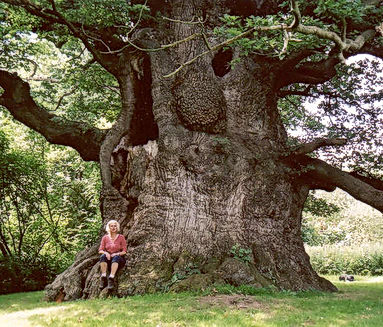
Majesty, the Fredville Oak, Kent, UK
Photo: Jeroen Philippona |
|
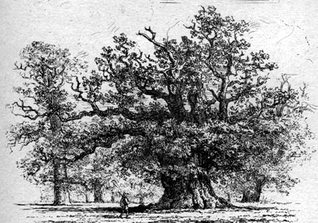
Majesty, the Fredville Oak
Britannia, 1830
Majesty's enormous trunk has a girth of 12.6 m and her age is estimated to be between 500 and 600 years (left). She is 19 m tall with a long trunk that makes it a "maiden tree" as opposed to a "pollarded" tree. Few ancient oaks in Britain have not been polled so as to produce a rounded head of small branches, a technique that was believed to extend the life of the tree. Majesty is a cherished natural monument; even though she grows on private property, she is fully protected by law. This is the opposite of BC where ancient trees have no protection from logging companies. |
|
| |
|
|
|
|
| |
The legendary oak that grew in Oele, near the village of Delden in the Province of Twenthe was called "De dikke Eik van Oele," and simply "Dikke Boom" (right). She was said to have the biggest trunk of all trees in the Netherlands. When she was measured in 1910, her circumference was 6.7 metres. The famous tree was struck by lightning in 1925, and two years later, it was blown down by a cyclone. The Dutch people did not forget "De dikke Eik" however, and in 1946, when World War II had ended, her stump was dug up and taken to the Natural History Museum of Enschede to be put on public display. Because the stump was hollow, the exact age of the tree was difficult to calculate by annual growth rings, but scientists estimated it to have been about 300 years old, originating in the early 17th century. |
|
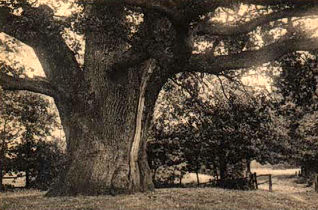
Dikke Boom, Delden, Nl, c. 1910
Old postcard |
|
| |
|
|
 |
|
| |
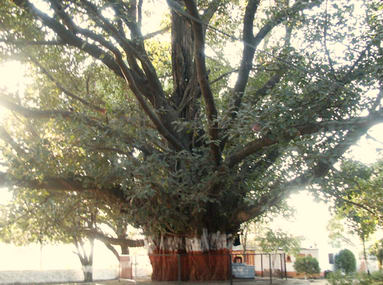
Sacred Tree, Kathgaria Temple, India
Photo: Shrifreedom |
|

Kusu-no-ki (Camphor Tree)
Atsuta Shrine, Nagoya. Spring 2008. Atsuta Shrine is surrounded by a park with trees up to and over 1000 years old, featuring elms, and zelkova trees, among others. Goshimboku is the biggest camphor tree among Shichihon-kusu (seven camphor trees). This 1,300 year old giant camphor tree, is said to have been planted by the renowned Buddhist priest Kobo Daishi. White snakes are said to live inside of the tree.
All over the world, ancient trees are respected, protected and even worshipped. In India, groves of ancient trees are venerated as natural sanctuaries where all living creatures are given protection by a deity or by ancestral spirits who imbue with ecological values. Preserved over many generations, sacred groves are often rich in biodiversity and provide a habitat for rare native species of plants and animals.
Some tribes such as the Bishnois of Rajasthan have a conservation based religious faith and refuse to fell any tree. Sacred groves define the cultural identity of the communities that revere and protect them. At the Kathgaria Temple, where the guru Hairakhan Baba meditated, there are several sacred trees that have grown together into one huge trunk (left). On the west coast of India, in Kerala, at least 2,000 sacred groves have been documented. |
|
| |
|
|
 |
|
| |
The "Chestnut Tree of the Hundred Horses," for which the slopes of Mount Aetna in Sicily are most famous, is a group of several trunks together forming a circle. It is pictured in a 1855 wood engraving (right). It is the largest and oldest known chestnut tree in the world, thought to be from 2,000 to 4,000 years old. Already when it was first measured in 1790, it had a recorded circumference of 57.9 m (190 ft). The tree's name originated from a legend in which a queen of Aragon and her company of 100 knights, during a trip to Mount Aetna, were caught in a severe thunderstorm and the entire cavalry is said to have taken shelter under the tree. The esteemed "Chestnut Tree of a Hundred Horses" and its legend have become the subject of various tributes, songs and poems, including a description in the Sicilian language by the Catanese poet Giuseppe Borrello. |
|
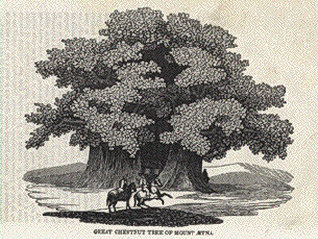
Great Chestnut Tree of Mount Aetna
Wood engraving, 1855 |
|
| |
|
|
|
|
| |
To celebrate the heritage trees of Germany, a German council of tree experts selects one particular species each year; "Baum des Jahre." In 2005 it was the "Rosskastanie," or Horse Chestnut (right). In 2006 – Schwarz Pappel, in 2007 – Wald Kiefer, in 2008 – Walnuss, and so on.
"The Chesnut is one of the most beautiful, best liked and best known trees in Europe. The shade given by the crown of the Horse Chestnut is very dense, making it an ideal tree for beer gardens. Many substances contained in the bark, leaves, flowers and fruits of the Horse Chestnut can be used in nature healing. Hardly any other tree species has so much to offer in this respect." It is a bitter irony that while the big trees in Europe are celebrated as icons of heritage, the indigenous ancient trees of BC are being exterminated by the insatiable greed of the rapacious global forest industry. |
|

Horse Chestnut, Tree of the Year
Baum des Jahres, Kuratorium |
|
| |
|
|
|
|
| |
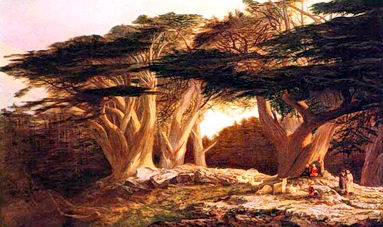
Cedars of Lebanon
Painting by Edward Lear, 1862 |
|
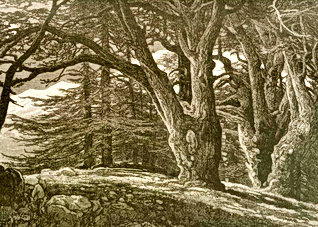
Cedars of Lebanon
Picturesque Palestine, 1885 |
| |
|
|
 |
|
| |
The famed Cedar of Lebanon (Cedrus Libani) is native to Lebanon where it once covered the entire range of Mount Lebanon. Symbolizing eternity, strength and endurance, the cedar has been celebrated throughout history. English artist Edward Lear depicted the cedars in a large painting in 1862 (above), and a wood engraving (above right) was published in the book "Picturesque Palestine, Sinai and Egypt" (1885). A monumental cedar is on the Lebanon national flag and ancient cedar trees and cedar groves are today cherished as natural treasures although few remain in existence.
Ancient Lebanese cedars were in heavy demand by the Mediterranean civilizations; Egyptians used the wood for shipbuilding and the oil for mummification; Solomon used cedars to construct the First Temple in Jerusalem; and the Ottoman Empire used them to build its railroad system. Today, after centuries of exploitation and deforestation, Lebanon's forest heritage has almost vanished. The Cedars of God (right) in the Kadisha Valley are among the last survivors of the immense native forests. Had the 102 hectare grove not been fenced by a high stone wall in 1876, financed by Britain's Queen Victoria out of her concern for the trees, the cedars would not be alive today. In 1998 the Cedars of God became a World Heritage Site. |
|
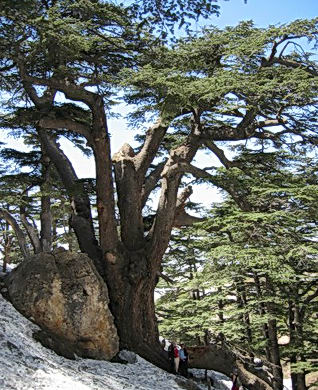
Cedars of God Grove, 2007
Kadisha Valley, Lebanon |
|
| |
|
|
|
|
| |
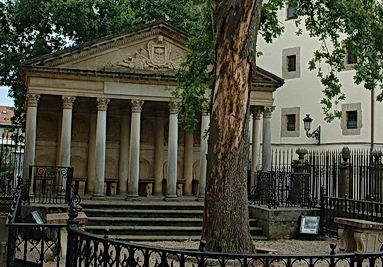
Third Tree of Gernika, 2003
Bizkaia, Basque Country
A new Tree of Gernika was planted on 25 February 2005. The original tree, "The Father," was planted in the 14th century and grew for 450 years. In 1811 the tree was replaced and its trunk was placed in a templet (right) in the surrounding garden where it is viewed today. The third Tree of Gernika (1858 – 2004) survived WWII bombing in 1937 but had to be replaced because of a fungus in 2004. |
|
The Tree of Gernika is a key symbol of Basque nationalism and identity. The tree, which is the Coat of arms of Bizkaia, grows outside the entrance to the oath taking tribune (left). The trunk of the "Old Tree" stands in the garden of the Casa de Juntas (Assembly House); this is the remains of the oldest preserved tree and it is displayed in a pillared templet building (below).
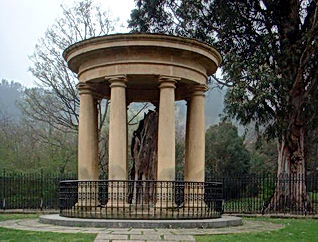
Trunk remains of the Tree of Gernika
Bizkaia, Basque Country |
|
| |
|
|
 |
|
| |
Of all European tree lovers, the Dutch are the most enthusiastic, judging by the number of tree websites in relation to the population. Indeed ever since the great age of exploration, the Dutch have been returning home with exotic botanical specimens. A giant redwood from California grows in the botanical garden Arboretum Poort – Bulten in Losser, the Netherlands (right). The enormous native trees which were discovered in California in 1852 quickly became a cult tree in Europe. A Belgian website documents this remarkable phenomenon in the Benlelux:
Mammoetboom. In Belgium there are 1043 specimens growing in 418 locations (in the Flemish province of Brabant 184 trees grow in 62 locations); in the Netherlands there are a total of 639 specimens growing in 336 locations; and in Luxemburg there are a total of 32 specimens growing in 7 locations.
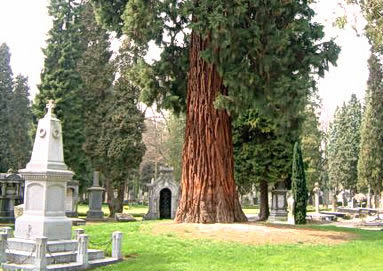
Redwood, Maastricht, Netherlands
Photo: Margriet Janssen |
|
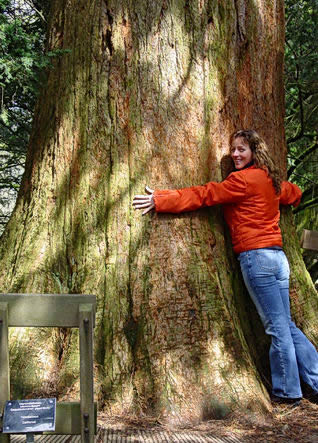
Aboretum Poort-Bulten, Netherlands
Photo: Jolanda
Another giant redwood (roughly 100 to 150 years old) grows in a cemetery in Maastricht (left). The sight of this venerable tree, native to California, surrounded by Dutch graves is amazing. Although the redwood species is not endangered, individual trees of a great age have become nearly extinct. |
|
| |
|
|
|
|
| |
|
|
|
|
| |
|
|
| |
|
|
|
|
| |
Belgian Tree Websites |
|
|
|
| |
|
|
|
|
| |
Mammoetboom
(Giant Sequoias) by Tim Bekaert |
|
| |
|
|
|
|
| |
|
|
| |
|
|
|
|
| |
British Tree Websites |
|
|
|
| |
|
|
|
|
| |
Ancient Tree Hunt
by the Woodland Trust |
|
|
|
| |
|
|
|
|
| |
Ancient Tree Forum by the Woodland Trust |
|
|
|
| |
|
|
|
|
| |
Ancient Yew Group by the Tree Register |
|
|
|
| |
|
|
|
|
| |
Global Tree Campaign by Fauna & Flora International |
|
| |
|
|
|
|
| |
Major Oak of Sherwood Forest by John Palmer |
|
|
|
| |
|
|
|
|
| |
Perthshire Big Tree Country by the Perthshire Forest Heritage and Access Project |
|
| |
|
|
|
|
| |
The Tree by Anna Fraser |
|
|
|
| |
|
|
|
|
| |
The Tree Council by the Tree Council |
|
|
|
| |
|
|
|
|
| |
The Tree Register by the Tree Register |
|
|
|
| |
|
|
|
|
| |
Treefest Scotland by the Forestry Commission of Scotland |
|
|
|
| |
|
|
|
|
| |
Trees for Life by the Caledonian Forest Centre |
|
| |
|
|
|
|
| |
|
|
| |
|
|
|
|
| |
Dutch Tree Websites |
|
 |
|
| |
|
|
|
|
| |
Anne Frank Tree by the Anne Frank Stichting |
|
| |
|
|
|
|
| |
Bijzondere Bomen in Brabant (Exceptional Trees in Brabant) by Han van Meegeren |
|
| |
|
|
|
|
| |
Bomengids (Tree Guide) by Hans–Cees Speel |
|
| |
|
|
|
|
| |
Bomenkennis (Tree Wisdom) by Leo Goudzwaard and Paula van Ling |
|
| |
|
|
|
|
| |
BoomBasTik (Fantastic Trees)
by Bas van Griensven |
|
|
|
| |
|
|
|
|
| |
Monumentale bomen (Monumental Trees) by Jeroen Pater |
|
|
|
| |
|
|
|
|
| |
Oude Bomen vanuit Zutphen bekeken (Old Trees in the Netherlands & Europe) by Jeroen Philippona |
|
| |
|
|
|
|
| |
Stem der Bomen (Mythology of Trees) by Brigit Kahlert |
|
| |
|
|
|
|
| |
|
|
| |
|
|
|
|
| |
French Tree Websites |
|
|
|
| |
|
|
|
|
| |
Les arbres remarquables de nos forets (Remarkable Trees in Our Forests) by Christiane Baroche |
|
| |
|
|
|
|
| |
Les Arbres Vénérables de la Planète (Venerable
Trees of the Earth) by Jerome Hutin |
|
| |
|
|
|
|
| |
|
|
| |
|
|
|
|
| |
German Tree Websites |
|
 |
|
| |
|
|
|
|
| |
Alte Baumriesen (Gigantic Old Trees) by Joerg Riedel |
|
| |
|
|
|
|
| |
Alte Liebenswerte Baeume (Old Trees of Value) by Hans Joachim Froehlich |
|
| |
|
|
|
|
| |
Baum des Jahres (Tree of the Year) by Kuratorium Baum des Jahres |
|
| |
|
|
|
|
| |
Baum Patriarchen (Tree Patriarchs) by Walter J. Pilsak |
|
| |
|
|
|
|
| |
Baum Veteranen (Tree Veterans) by Juergen Huefner |
|
| |
|
|
|
|
| |
Baumkreis (The Tree Circle) by Dietmar Findling |
|
| |
|
|
|
|
| |
Bemerkenswerte Baeume (Remarkable Trees) by Andreas Gomolka |
|
| |
|
|
|
|
| |
Baeume und Waelder (Trees and Forests) by Walter J. Pilsak |
|
| |
|
|
|
|
| |
Global
Tree by Ralf Alexis Ruf |
|
| |
|
|
|
|
| |
Ivenacker Eichen (Ivenack Oaks) by the Ivenack Oak Society |
|
| |
|
|
|
|
| |
|
|
| |
|
|
|
|
| |
Irish Tree Websites |
|
|
|
| |
|
|
|
|
| |
The Tree Council by the Tree Council |
|
| |
|
|
|
|
| |
|
|
| |
|
|
|
|
| |
Italian Tree Websites |
|
|
|
| |
|
|
|
|
| |
Alberi monumentali (Monumental Trees) by Stefano Rosini |
|
|
|
| |
|
|
|
|
| |
Alberi Monumentali d'Italia (Italian Monumental Trees) by G. Bortolotti |
|
| |
|
|
|
|
| |
Arte Sella: Incontri Internazionali Arte Natura (International Nature Art) by Arte Sella |
|
| |
|
|
|
|
| |
|
|
| |
|
|
|
|
| |
Polish Tree Websites |
|
 |
|
| |
|
|
|
|
| |
Oaks of Puszcza Bialowieska by Tomasz Niechoda |
|
|
|
| |
|
|
|
|
| |
|
|
| |
|
|
|
|
| |
Spanish Tree Websites |
|
|
|
| |
|
|
|
|
| |
Arbres Monumentals (Monumental Trees) by Jordi Nadal |
|
| |
|
|
|
|
| |
|
|
| |
|
|
|
|
| |
Swedish Tree Websites |
|
|
|
| |
|
|
|
|
| |
Eklandskapet
(The Oak Landscape) by Claes Svedlindh |
|
| |
|
|
|
|
| |
Jaettetraed i Sverige (Giant Trees in Sweden) by Naturcentrum |
|
| |
|
|
|
|
| |
Fotoutställningen Jaettetraed (Gallery of Giant Trees) by Patrik Nygren |
|
| |
|
|
|
|
| |
|
|
| |
|
|
|
|
| |
Swiss Tree Websites |
|
 |
|
| |
|
|
|
|
| |
Internationales Baum Archiv
(International Tree Archive) by the International Tree Archive Foundation |
|
| |
|
|
|
|
| |
|
|
| |
©
Credits & Contact |
|
| |
|
|
|
|

